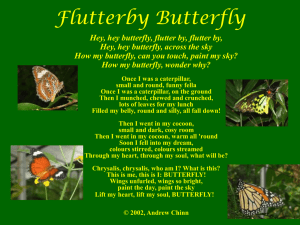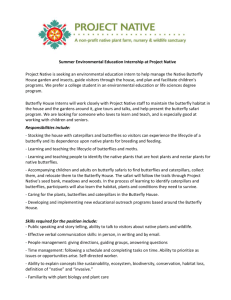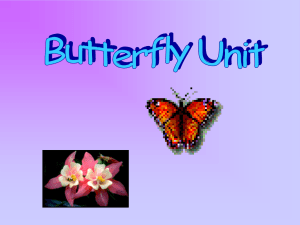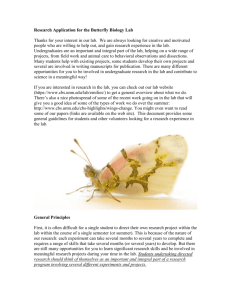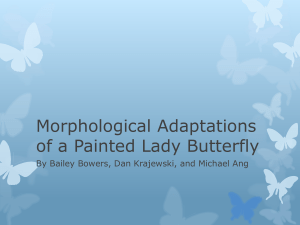Beautiful Butterflies
advertisement
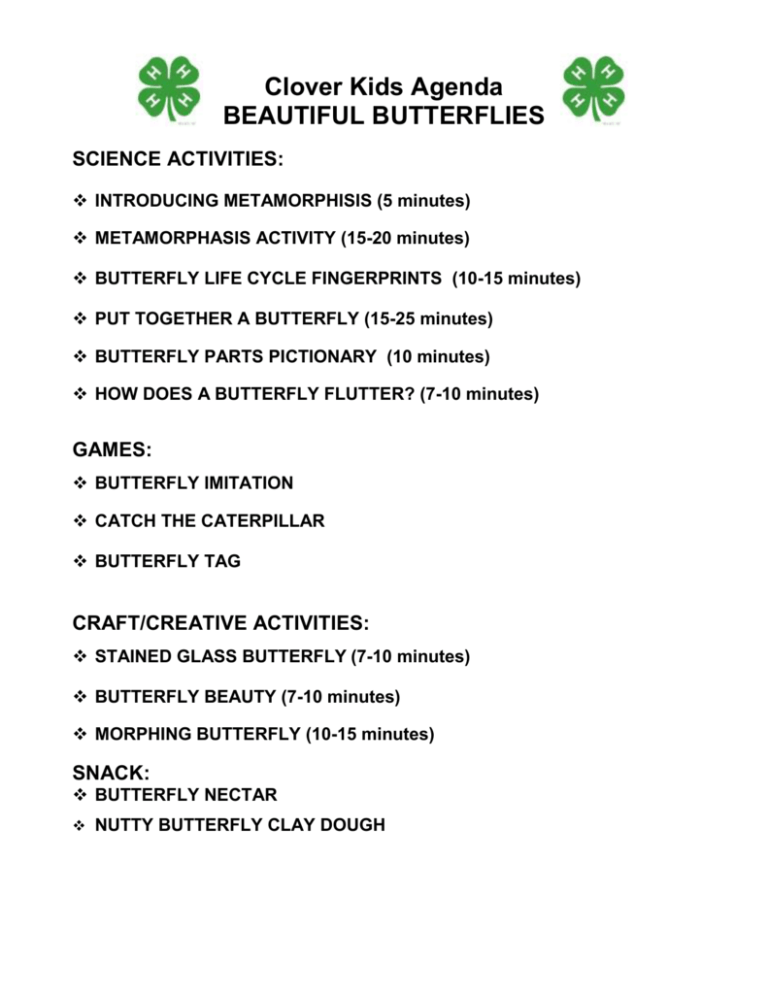
Clover Kids Agenda BEAUTIFUL BUTTERFLIES SCIENCE ACTIVITIES: INTRODUCING METAMORPHISIS (5 minutes) METAMORPHASIS ACTIVITY (15-20 minutes) BUTTERFLY LIFE CYCLE FINGERPRINTS (10-15 minutes) PUT TOGETHER A BUTTERFLY (15-25 minutes) BUTTERFLY PARTS PICTIONARY (10 minutes) HOW DOES A BUTTERFLY FLUTTER? (7-10 minutes) GAMES: BUTTERFLY IMITATION CATCH THE CATERPILLAR BUTTERFLY TAG CRAFT/CREATIVE ACTIVITIES: STAINED GLASS BUTTERFLY (7-10 minutes) BUTTERFLY BEAUTY (7-10 minutes) MORPHING BUTTERFLY (10-15 minutes) SNACK: BUTTERFLY NECTAR NUTTY BUTTERFLY CLAY DOUGH INTRODUCING METAMORPHISIS What you need: Pictures of parent and baby animals including caterpillar and butterfly What you do: Mix up the stack of pictures and have the children match up the baby and parent animals. Ask them "How did you know that each pair belonged together." (For the cat, dog, and horse the juveniles look similar to the adults.) Ask the students, "How were you able to match up the butterfly with the caterpillar?” (Accept reasonable responses.) Explain to the students, "The caterpillar and the tadpole look nothing like the adult. This means that they have to go through a change during their lives in order to become an adult. This is called a metamorphosis." METAMORPHASIS ACTIVITY What you need: Paper plates Markers Elbow macaroni Shell macaroni Bowtie macaroni Yarn What you do: Pass out the plates and have the children divide the plates into 4 sections by drawing lines across the middle horizontally and vertically. Tell them they are going to make a diagram of the 4 stages of the butterfly’s life cycle. Use your markers or crayons to draw a leaf with dots on it in the upper left corner of the paper plate to represent the butterfly eggs on a leaf. In the upper right corner draw a leaf and glue a piece (or more if room allows) of elbow macaroni on it. In the lower right corner draw a stick with a leaf or two on it and glue a piece (or more if room allows) of shell macaroni on it. In the lower left corner glue a piece (or more if room allows) of bowtie macaroni. Let the glue dry. After the glue has dried instruct the students decorate the elbow macaroni to look like a caterpillar, decorate the shell macaroni to look like a cocoon, draw a body and antenna for each bowtie macaroni and decorate them like butterflies. Tie a string through the hole in the top of the plate for a hanger. BUTTERFLY LIFE CYCLE FINGERPRINTS What you need: Inked stamp pads or water soluble paint Paper Crayons Markers Fingers! What you do: Press fingertips/ thumbprints on a stamp pad and then on paper to create the life cycle of a butterfly. (Egg on a leaf; Caterpillars crawling around; Chrysalis hanging from a twig; Butterflies all around!) Use markers or crayons to add details, transforming your prints into illustrations BUTTERFLY LIFE CYCLE PRINT OUT PAGE Color these pictures. Then cut them out, and paste or tape them onto the life cycle chart. Be sure to match each picture to the correct life cycle stage, in order from egg to butterfly! http://www.earthsbirthday.org/butterflies/activitykit/unit2-g.html PUT TOGETHER A BUTTERFLY What you need: Butterfly parts pictures (see last page) Scrap materials like: butter containers, cardboard, wall paper books, etc. Craft materials like craft sticks, yarn, google eyes, chenille sticks, straws etc. What you do: Show the children the parts of a butterfly. Then in groups they should construct their own butterfly using the materials provided making sure they include all the parts. BUTTERFLY PARTS PICTIONARY Divide the class into two teams. Have one student artist at the chalkboard for each team. When that team guesses the body part, the artist draws it on the board. When the butterfly is complete - the game is finished! HOW DOES A BUTTERFLY FLUTTER? Insects use a variety of muscles when they fly. Certain insects, including butterflies, flap their wings by contracting the thorax (the body part to which legs and wings are attached). Some muscles lift the wings by depressing the thorax, while others raise the top of the thorax and lower the wings. You can build a simple model to show how this system works. What You Need: cardboard toilet paper tube index card scissors clear tape What you do: 1. Make two longitudinal cuts along a toilet paper tube. Cut the tube so that you are making two portions -- one larger and one smaller. 2. Cut an index card in half, and tape each half to an edge of the larger portion of the tube, leaving about 1-1/2 inch overhanging towards the middle of the tube. 3. Tape the edges of the smaller portion of the tube to the inner edges of the cards. Orient this "thorax" model with the smaller tube portion on top. 4. While holding the bottom (larger) tube section, press down then release the upper section. The index card "wings" will begin to flap up and down. BUTTERFLY IMITATION Butterflies have 4 basic activities they do that are necessary for life. They are: What you need: Straws Scarves (for wings) What you do: The leader calls out an activity and the group acts that activity out until another activity is called out. This happens very quickly! Activities: BASKING: Since butterflies are cold blooded, they need to absorb heat from the sun. When you see them with their wings stretched out in the sunlight, that is probably what they are doing. NECTARING: Butterflies do not have any chewing mouth parts. Instead, they eat by sipping liquids, most often nectar, through their proboscis. PUDDLING: Many male butterflies can be found sipping at the moisture in puddles or wet sand and soil. These butterflies are getting more than water when they sip! They are also benefiting from the salts dissolved in this water. MATING DANCE: Attracting a mate by moving around to get attention. CATCH THE CATERPILLAR What you need: Paper towels Small balls Yarn Markers Pennies Large paper circle Large funnel Die What you do: Let each child make a 3-piece caterpillar as with egg cartons. Tie a 2-foot piece of yarn around the caterpillar. Choose one person to be the bird. The other players lay their caterpillars on the large paper circle and hold on to the yarn leash. The bird holds the funnel, upside down, at least 2 feet above the circle. Each child is given a number from 1 to 6. The bird chooses rolls the die. The child whose number is rolled must pull his/her caterpillar out of the circle before the bird can slam the funnel down over them. Then that person can become the bird, or choose another player to be the bird. BUTTERFLY TAG What you need: Large area for running Picture to review butterfly parts What you do: Choose one or two people to be “the bird”. Everyone else is a butterfly. “The Bird” chases everyone around chases everyone around trying to catch them. When caught, the butterfly can remain alive by squatting down and saying the name of a butterfly part. Then they are allowed to get up and run some more. If they can’t think of a part, they can become “the bird.” STAINED GLASS BUTTERFLY http://www.enchantedlearning.com/crafts/butterfly/stainedglass/printable.shtml What you need: Wax paper Crayon shavings Iron Scissors Yarn Kitchen Towel What you do: Fold 2 pieces of wax paper in half and cut out a half of a butterfly pattern. Unfold. Take the top piece off and put crayon shavings on it. Then lay the other piece on top of it. Place a thin kitchen towel on top and iron until the crayon melts. Then punch a hole and hang with yarn. BUTTERFLY BEAUTY Patterns are all around us: on clothes, sidewalks, trees, flowers, and even bugs! If you look closely, you'll notice that for many objects in nature, one side is the mirror image of the other side. Imagine a line drawn down the object's center--when each side is the same we say the object is symmetrical. Have fun creating your own symmetrical butterfly wings! What you need: plain paper for the butterfly template, paints, scissors What you do: Draw and cut out a butterfly shape. Place a few drops of paint on one butterfly wing. Fold the paper in half, pressing the two wings together until the paint is absorbed on both wings. Open up the folded wings and notice the symmetrical design MORPHING BUTTERFLY http://www.hhmi.org/coolscience/butterfly/ What you need: Toilet paper tube Craft Stick Heavy paper 6" (150 mm) piece of pipe cleaner, folded in half Markers or crayons Scissors and glue What you do: Cut out and color a butterfly from the heavy paper. Use any colors, but make both halves look the same. Put a small hole at the top of the butterfly's head. Color the toilet paper tube to look like a chrysalis. (A monarch butterfly's chrysalis is green, but you can use any color.) Take a piece of pipe cleaner and shape it like the letter "V". Put one point through the little hole in the butterfly's head and then twist it to look like antennae. Butterflies use these "feelers" to learn about their environment. Glue the butterfly to one end of the tongue depressor or ice-cream pop stick. Let the glue dry. Curl the butterfly's wings and slide it into the chrysalis. Pull the stick to make the beautiful butterfly come out of the chrysalis. Fly your butterfly like a real one! BUTTERFLY NECTAR Materials Needed: Drinking cups; Paper; Crayons; Tape; Straws; Measuring cups. 1. Measure strips of paper to fit around the cups. 2. Have children color flowers on the paper, then tape it around their cup. 3. Pass out one straw per child. 4. Mix and serve your butterfly nectar. Nectar Recipe: (1) can frozen orange juice (4) cups water (2) cups lemon/lime soda (1) Pint lemon sherbet (instead of ice). Mix first three ingredients well. Add one little scoop of lemon sherbet to each cup. Pour nectar into each cup. Serve, and sip through your straws like butterflies! NUTTY BUTTERFLY CLAY DOUGH This modeling clay has a special feature Ð you can eat whatever you make with it! What you need: Medium mixing bowl Large spoon Rolling pin Butterfly-shaped cookie cutters Measuring cups. Clay Recipe: 1/2 Cup smooth peanut butter 1/2 Cup honey (1) Cup dry powdered milk What you do: Mix all ingredients in the bowl. Once the texture becomes pliable, its' ready for rolling, pinching, squeezing, and shaping. If your mixture is too wet, just add a little more powdered milk. For eggs: Roll small balls of clay. For caterpillars: Roll several small balls of clay, smash with palm, and then pinch each section together Ð end to end. For chrysalides: Roll small ball of clay, then place on table. Using your palm, roll the clay into long, cylinder shapes Ð fat in the middle, and tapered on the ends. For butterflies: Roll out dough with rolling pin. Use cookie cutter to make butterfly shapes. Don't bake . . . just eat! BUTTERFLY PARTS BACKGROUND The head is at the front, and the thorax is in the middle. The butterfly's legs and wings grow from the thorax. The biggest part of a butterfly is the abdomen, which is at the back. Butterflies have six legs and four wings. The wings are covered with tiny flat colored scales. These help to make the beautiful patterns on their wings. Butterflies have two large eyes on their heads. These are called compound eyes. Compound eyes are made up of many tiny parts that are sensitive to light and movement. A butterfly has a pair of antennae that help it smell and feel. Many butterflies taste with their feet. On the first pair of feet there is a kind of brush. This helps the butterfly to clean its antennae. Butterflies have a long curled tube called a proboscis, which is used to suck up nectar from flowers. When the butterfly is not using its proboscis, it is rolled up. Butterflies do not have bones. Instead, each part of their bodies is covered with a hard coating that protects it. IS A BUTTERFLY AN INSECT? PRINT OUT PAGE http://www.earthsbirthday.org/butterflies/activitykit/unit3-g.html




